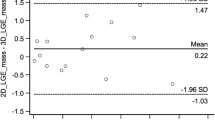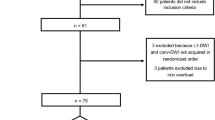Abstract
Objectives
To assess the feasibility of high-resolution 3D-gradient-recalled echo (GRE) fat-suppressed T1-weighted images using controlled aliasing acceleration technique (CAIPIRINHA-VIBE), and compare image quality and lesion detection to standard-resolution 3D-GRE images using conventional acceleration technique (GRAPPA-VIBE).
Materials and methods
Eighty-four patients (41 males, 43 females; age range: 14–90 years, 58.8 ± 15.6 years) underwent abdominal MRI at 1.5 T with CAIPIRINHA-VIBE [spatial resolution, 0.76 ± 0.04 mm] and GRAPPA-VIBE [spatial resolution, 1.17 ± 0.14 mm]. Two readers independently reviewed image quality, presence of artefacts, lesion conspicuity, and lesion detection. Kappa statistic was used to assess interobserver agreement. Wilcoxon signed-rank test was used for image qualitative pairwise comparisons. Logistic regression with post-hoc testing was used to evaluate statistical significance of lesions evaluation.
Results
Interobserver agreement ranged between 0.45-0.93. Pre-contrast CAIPIRINHA-VIBE showed significantly (p < 0.001) sharper images and lesion conspicuity with decreased residual aliasing, but more noise enhancement and inferior image quality. Post-contrast CAIPIRINHA-VIBE showed significantly (p < 0.001) sharper images and higher lesion conspicuity, with less respiratory motion and residual aliasing artefacts. Inferior fat-suppression was noticeable on CAIPIRINHA-VIBE sequences (p < 0.001).
Conclusion
High in-plane resolution abdominal 3D-GRE fat-suppressed T1-weighted imaging using controlled-aliasing acceleration technique is feasible and yields sharper images compared to standard-resolution images using standard acceleration, with higher post-contrast image quality and trend for improved hepatic lesions detection.
Key Points
• High-resolution imaging of the upper abdomen is clinically feasible using 2D-controlled aliasing acceleration technique.
• High-resolution imaging yields significantly sharper images and increased hepatic lesions conspicuity.
• High-resolution imaging yields significantly less respiratory motion and residual aliasing artefacts.
• Controlled-aliasing offers substantial acquisition-time reduction in patients with breath-holding difficulties.





Similar content being viewed by others
Abbreviations
- ACS:
-
Autocalibration signal
- AF:
-
Acceleration factor
- ARC:
-
Autocalibrating reconstruction for cartesian sampling
- ASSET:
-
Array spatial and sensitivity encoding technique (ASSET)
- CAIPIRINHA:
-
Controlled aliasing in parallel imaging results in higher acceleration
- CARE:
-
Combined applications to reduce exposure
- GBCA:
-
Gadolinium-based contrast agent
- GRAPPA:
-
Generalized autocalibrating partially parallel acquisition
- GRE:
-
Gradient-recalled echo
- HIPAA:
-
Health insurance portability and accountability act
- iPAT:
-
Integrated parallel acquisition technique
- IRB:
-
Institutional review board
- RAPID:
-
Rapid acquisition through parallel imaging design
- SENSE:
-
SENSitivity encoding for fast MRI
- SMASH:
-
SiMultaneous acquisition of spatial harmonics
- SNR:
-
Signal-to-noise ratio
- T:
-
Tesla
- TE:
-
Echo time
- TR:
-
Repetition time
- VIBE:
-
Volume-interpolated breath-hold examination
References
Hamm B, Laniado M, Saini S (1990) Contrast-enhanced magnetic resonance imaging of the abdomen and pelvis. Magn Reson Q 6:108–135
Holalkere N-S, Sahani DV, Blake MA et al (2006) Characterization of small liver lesions: Added role of MR after MDCT. J Comput Assist Tomogr 30:591–596
Fujita T, Honjo K, Ito K et al (1997) High-resolution dynamic MR imaging of hepatocellular carcinoma with a phased-array body coil. Radiographics 17:315–331, discussion 332–5
Kanematsu M, Hoshi H, Murakami T et al (1999) Detection of hepatocellular carcinoma: comparison of low- and high-spatial-resolution dynamic MR images. AJR Am J Roentgenol 173:1207–1212
Namimoto T, Yamashita Y, Yamamoto H et al (1998) High resolution breath-holding MR imaging of the abdomen with a phased-array multicoil. Comput Med Imaging Graph 22:301–308
Rofsky NM, Lee VS, Laub G et al (1999) Abdominal MR imaging with a volumetric interpolated breath-hold examination. Radiology 212:876–884
Sodickson DK, Manning WJ (1997) Simultaneous acquisition of spatial harmonics (SMASH): fast imaging with radiofrequency coil arrays. Magn Reson Med 38:591–603
Pruessmann KP, Weiger M, Scheidegger MB, Boesiger P (1999) SENSE: sensitivity encoding for fast MRI. Magn Reson Med 42:952–962
Griswold MA, Jakob PM, Heidemann RM et al (2002) Generalized autocalibrating partially parallel acquisitions (GRAPPA). Magn Reson Med 47:1202–1210
Weiger M, Pruessmann KP, Boesiger P (2002) 2D SENSE for faster 3D MRI. MAGMA 14:10–19
Heredia V, Dale B, Op de Campos R et al (2013) A comparison of a T1 weighted 3D gradient-echo sequence with three different parallel imaging reduction factors, breath hold and free breathing, using a 32 channel coil at 1.5T. A preliminary study. Radiologia. doi:10.1016/j.rx.2012.06.014
Breuer FA, Blaimer M, Mueller MF et al (2006) Controlled aliasing in volumetric parallel imaging (2D CAIPIRINHA). Magn Reson Med 55:549–556
Riffel P, Attenberger UI, Kannengiesser S et al (2013) Highly accelerated T1-weighted abdominal imaging using 2-dimensional controlled aliasing in parallel imaging results in higher acceleration: a comparison with generalized autocalibrating partially parallel acquisitions parallel imaging. Invest Radiol 48:554–561
Wright KL, Harrell MW, Jesberger JA et al (2014) Clinical evaluation of CAIPIRINHA: comparison against a GRAPPA standard. J Magn Reson Imaging 39:189–194
Yu MH, Lee JM, Yoon J-H et al (2013) Clinical application of controlled aliasing in parallel imaging results in a higher acceleration (CAIPIRINHA)-volumetric interpolated breathhold (VIBE) sequence for gadoxetic acid-enhanced liver MR imaging. J Magn Reson Imaging 38:1020–1026
Zhuo J, Gullapalli RP (2006) AAPM/RSNA physics tutorial for residents: MR artifacts, safety, and quality control. Radiographics 26:275–297
Deshmane A, Gulani V, Griswold MA, Seiberlich N (2012) Parallel MR imaging. J Magn Reson Imaging 36:55–72
Merkle EM, Dale BM, Paulson EK (2006) Abdominal MR imaging at 3T. Magn Reson Imaging Clin N Am 14:17–26
R Core Team (2014) R: A Language and environment for statistical computing. Vienna, Austria
Landis JR, Koch GG (1977) The measurement of observer agreement for categorical data. Biometrics 33:159–174
Yoon J-H, Lee JM, Yu MH et al (2014) High-resolution T1-weighted gradient echo imaging for liver MRI using parallel imaging at high-acceleration factors. Abdom Imaging 39:711–721
Lee ES, Lee JM, Yu MH et al (2014) High spatial resolution, respiratory-gated, t1-weighted magnetic resonance imaging of the liver and the biliary tract during the hepatobiliary phase of gadoxetic Acid-enhanced magnetic resonance imaging. J Comput Assist Tomogr 38:360–366
Acknowledgments
The scientific guarantor of this publication is Richard C. Semelka. One author (Dale B) works for Siemens. The rest of the authors (AlObaidy M, Ramalho M, Busireddy K, Liu B, Burke L, Altun E, Semelka R) of this manuscript declare no relationships with any companies, whose products or services may be related to the subject matter of the article. The authors state that this work has not received any funding. No complicated statistical work was needed for this paper. One of the authors, with no conflict, performed the statistical work. Institutional Review Board approval was obtained. Written informed consent was waived by the Institutional Review Board. Study type: prospective case–control performed at one institution.
Author information
Authors and Affiliations
Corresponding author
Rights and permissions
About this article
Cite this article
AlObaidy, M., Ramalho, M., Busireddy, K.K.R. et al. High-resolution 3D-GRE imaging of the abdomen using controlled aliasing acceleration technique – a feasibility study. Eur Radiol 25, 3596–3605 (2015). https://doi.org/10.1007/s00330-015-3780-6
Received:
Revised:
Accepted:
Published:
Issue Date:
DOI: https://doi.org/10.1007/s00330-015-3780-6




